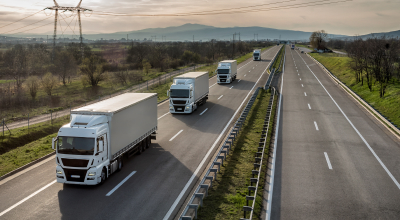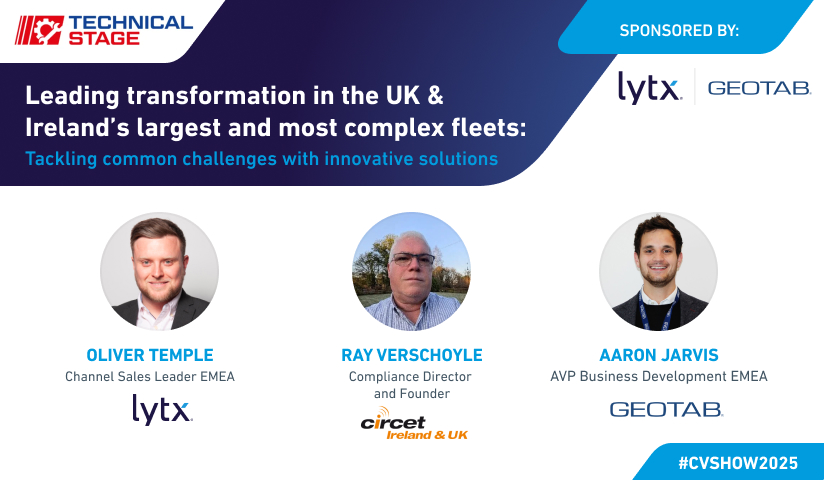CV Show 2025: Putting Drivers at the Center of the Telematics Journey

The Lytx® team recently attended the Commercial Vehicle (CV) Show at Birmingham. The three-day event gathers leaders from across the transport sector to discuss the most pressing issues affecting commercial fleets. Oliver Temple, who leads our channel sales, took part in a panel discussion alongside Aaron Jarvis, AVP EMEA of strategic partner Geotab and Ray Verschoyle, head of transport compliance for Circet Ireland and UK, to discuss how fleets are tackling common challenges in video telematics.

The discussion covered a range of topics, but three key takeaways stood out from the session:
1. Stakeholder Buy-in Is Key for Every Size of Fleet – At Every Stage of the Telematics Journey
The fleets of Geotab and Lytx customers vary greatly in size. Circet has the largest privately run fleet in Ireland with over 3,000 vehicles, but others can be as large as 30,000 or more. Fleets may also introduce video at different stages of their telematics implementations. Circet started using AI cameras six years ago and is now benefitting from both in-cab and external facing cameras to protect its drivers and other road users. It’s not uncommon, however, for cameras to be integrated with long-established telematics systems.
No matter the size of a fleet, it’s essential to engage with all stakeholders right from the start when implementing new technology. Ray commented that Circet had worked closely with driver’s representatives since day one, communicating with complete openness and transparency. The panel agreed that sharing information with driver’s representatives - not only the objectives behind the implementation but also the way in which the data collected by video telematics would be used and stored – is key. In some cases, this could involve debunking myths about technology that may have gained traction.
Finally, Oliver pointed out that a successful implementation of video telematics ultimately boils down to an understanding between driver’s representatives and employers that they share one overarching priority - the driver.
2. Drivers Must Be at the Center of Video Implementation
Video telematics is all about the driver. Protecting them, empowering them and training them. When implementing the technology, it’s essential that nobody loses sight of this. Ray explained how, during the company’s introduction of inward and outward facing cameras, the team found that focusing on each individual feature of the video technology helped them to keep the drivers aware that they were at the heart of the story. For example, in order to help address driver privacy concerns, Circet limits the recording function to operate only when triggered by a driving event. And only a small number of people are permitted to access the recording. Drivers are aware that the cameras are there to help and exonerate them in the event of an incident that was not their fault.
It was pointed out that in some sectors, the professional driving the van may in fact be an engineer so would not think of themselves as a “driver” – so there’s a mindset shift involved. For these individuals, driving the vehicle simply enables them to carry out their principal job. Getting people to where they need to be safely and efficiently is still essential, however. That involves not only providing excellent maintenance for the vans but also ensuring that vehicles aren’t damaged by accidents on the road.
For all organisations, different drivers will require different levels of training for different technical features. But in all cases, the driver is the most important asset in the fleet.
3. Data Matters
When looking ahead at the next five years, the panel talked about ESG challenges with the changes in EU regulations and about the impact of AI. Where these points converged was in the ability to understand what’s happening, which comes down to data. Drivers must be given information about their driving in order to autocorrect. Fleet leaders need to have data about emissions and to understand the different factors that are driving them. Sometimes these two things cross over. Ray commented, for example, that emissions can be reduced dramatically simply by improving driver training.
Oliver remarked that many organisations are looking for a single silver bullet to solve their sustainability, safety and efficiency challenges. In fact, as he pointed out, telematics data, both video and non-video, needs to be gathered from different sources and analysed for different purposes. For example, fleet managers need month-on-month figures about risky driving, while insurers can use telematics data to assess risk more accurately.
As emphasised by Ray, fleets need to have the right technology to share data effectively with different audiences - whether that’s a driver, a safety officer, or your board of directors.
